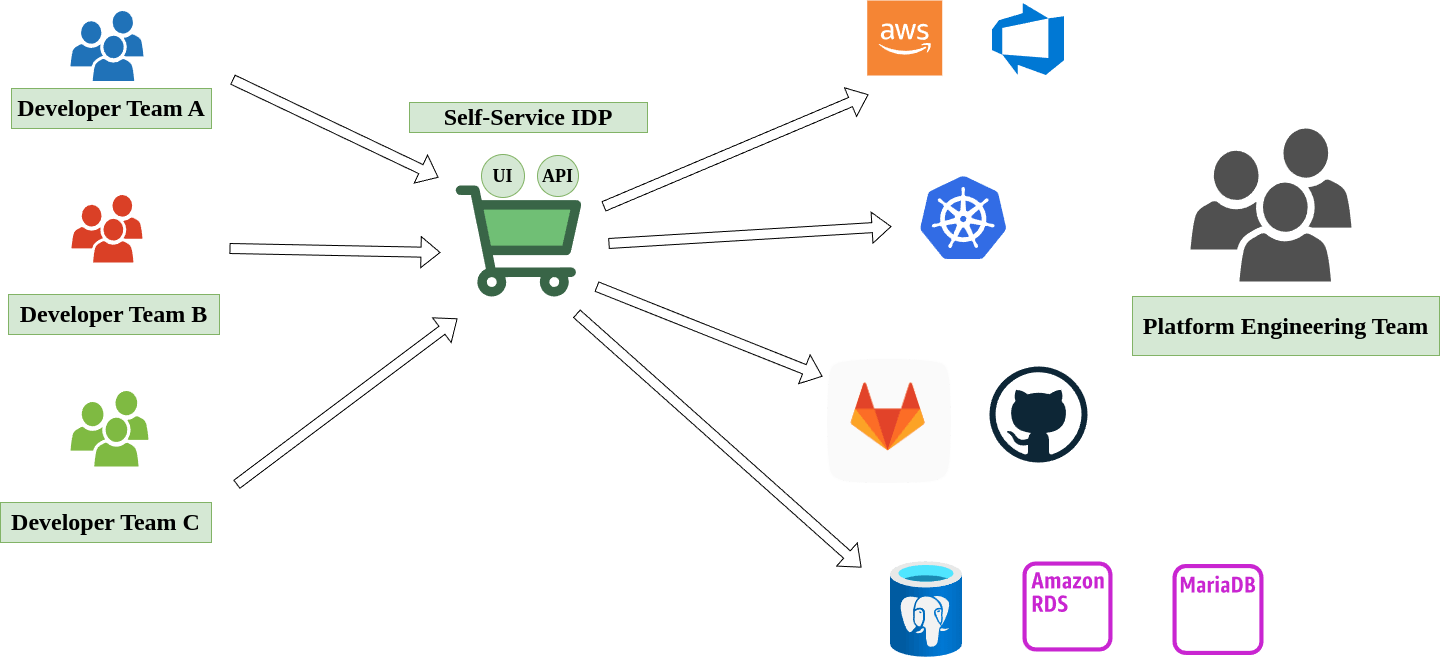Platform engineering is essentially the practice of designing and building internal tools and workflows as a product that empower software development teams by providing them a self-service capabilities. These tools and workflows are aimed to make developers more efficient and decrease the overall team's cognitive load.
Imagine a platform engineering team as the builders of an internal development platform (IDP) for the rest of the software engineers in the company. This IDP would provide a collection of tools that address the entire lifecycle of an application, streamlining the development process. This IDP can be accessed by developer teams via user-friendly UI or API endpoints and does not require the direct interaction with operations team.

Key aspects of Platform Engineering
Standardization
Platform engineering involves establishing standards for development and operational processes. This could include coding standards, container orchestration, continuous integration and delivery (CI/CD) pipelines, and monitoring tools. Standardization helps reduce complexity and allows developers to focus on writing code rather than managing infrastructure.
Automation
Automation is a cornerstone of platform engineering. By automating repetitive tasks such as deployments, testing, and scaling operations, teams can minimize human error, increase efficiency, and ensure consistent processes across the development lifecycle.
Self-service Capabilities
Platform engineering often involves building self-service portals or tools that enable developers to provision resources, deploy applications, and access services without needing direct intervention from the operations team. This empowers developers and reduces bottlenecks in the development process.
Scalability and Reliability
The platforms engineered are designed to be scalable and reliable, ensuring that applications can handle varying loads and recover from failures gracefully. This involves choosing the right technologies and architectures (such as microservices or serverless computing), implementing load balancing, and ensuring high availability and disaster recovery capabilities.
Security and Compliance
Security is integrated into the platform through practices like secure coding standards, automated vulnerability scanning, and identity and access management. Platform engineering also addresses compliance requirements by providing tools and processes that help in adhering to industry standards and regulations.
Monitoring and Observability
To ensure the smooth operation of applications and infrastructure, platform engineering includes setting up comprehensive monitoring and observability tools. These tools help in tracking the performance of applications, diagnosing issues, and understanding the behavior of systems in production.
Developer Experience
A significant focus of platform engineering is improving the developer experience. By providing a well-designed, easy-to-use platform, platform engineering aims to make the development process more enjoyable and productive, which in turn can lead to higher-quality software. Platform Engineering helps to decrease the overall Developer Team's cognitive load.
Why Platform Engineering Emerged?
Platform engineering emerged as a response to several evolving needs and challenges in the software development and operational landscape. The invention and rise of platform engineering can be attributed to a combination of factors that sought to address specific gaps and inefficiencies in traditional software development and deployment processes. Here are the key reasons behind the invention of platform engineering:
1. Need for Developer Efficiency and Productivity
As software development became more complex and the pace of development accelerated, it became clear that developers were spending a significant amount of time on repetitive tasks and managing infrastructure rather than focusing on writing code and creating value through new features. Platform engineering aims to abstract these complexities, providing developers with tools, platforms, and environments that allow them to be more productive and focus on core development tasks.
2. Growing Complexity of Software and Infrastructure
Modern software applications are increasingly complex, often designed as distributed systems that run on dynamic, cloud-based infrastructure. Managing this complexity requires specialized knowledge and tools. Platform engineering teams build and maintain the infrastructure and tooling needed to deploy, manage, and scale these complex systems efficiently.
3. Standardization and Consistency
With the adoption of microservices architectures, containerization, and cloud-native technologies, there was a growing need for standardization across development and operational processes to ensure consistency, reliability, and security. Platform engineering provides standardized development environments, deployment pipelines, and operational practices that help in maintaining consistency across the software development lifecycle.
4. Acceleration of DevOps and Agile Practices
The rise of DevOps and agile methodologies highlighted the importance of collaboration, rapid iteration, and continuous delivery. Platform engineering supports these practices by providing the infrastructure and tooling that enable rapid, reliable, and automated software releases, thereby aligning with the principles of DevOps and agile.
5. Demand for Scalability and Reliability
As businesses increasingly rely on digital products and services, the demand for scalable, reliable, and high-performing applications has never been higher. Platform engineering focuses on building scalable infrastructure and platforms that can handle fluctuating workloads and ensuring that applications are reliable and available to meet user expectations.
6. Evolution of Cloud Computing and Infrastructure as Code
The advent of cloud computing and the practice of infrastructure as code (IaC) transformed the way organizations provision and manage infrastructure. Platform engineering leverages these advancements to automate infrastructure management, reduce costs, and improve infrastructure scalability and reliability.
Platform Engineering vs DevOps vs SRE
Platform Engineering, DevOps, and Site Reliability Engineering (SRE) are closely related disciplines within the realm of software development and operations, with overlapping goals of improving software delivery, reliability, and operational efficiency. Despite their shared objectives, they focus on different aspects of the software development lifecycle and operational processes. Understanding the distinctions can help clarify the roles and responsibilities of each discipline.
Platform Engineering
Focus: Platform Engineering concentrates on building and maintaining the internal tools, platforms, and infrastructure that enable developers and operations teams to deploy and manage applications more efficiently. It emphasizes creating a self-service model for developers to access the resources and tools they need, thereby reducing operational bottlenecks and enabling faster development cycles.
Goal: The primary goal is to enhance developer productivity and operational efficiency by standardizing development environments, automating infrastructure management, and providing scalable and reliable platforms.
Outcome: A streamlined, consistent, and efficient development and deployment process that supports scalable application development.
DevOps
Focus: DevOps is a cultural and professional movement that aims to bridge the gap between development (Dev) and operations (Ops) teams. It focuses on collaboration, automation, continuous integration (CI), continuous delivery (CD), and fast feedback loops to enable rapid and reliable software releases.
Goal: The goal of DevOps is to improve the speed, efficiency, and quality of software development and deployment by fostering a collaborative environment and implementing practices that integrate development and operations workflows.
Outcome: Improved collaboration between developers and operations, faster time to market, and more frequent releases with fewer deployment failures.
Site Reliability Engineering (SRE)
Focus: SRE is a discipline that incorporates aspects of software engineering into the operational domain to create highly reliable and scalable software systems. Originating at Google, SRE focuses on automation, infrastructure as code, and operational best practices to ensure system reliability, performance, and efficiency.
Goal: The goal of SRE is to maintain and improve the reliability, availability, and performance of services and applications through engineering solutions and defined service level objectives (SLOs) and service level indicators (SLIs).
Outcome: High system reliability and performance, efficient incident management, and a balanced approach to new feature development and operational stability.
Key Differences in Roles
Think of it this way:
Platform engineers build the developer's workbench, equipping them with the right tools.
DevOps engineers optimize the assembly line, ensuring a smooth flow of work.
SRE engineers maintain the factory, ensuring it runs reliably and efficiently.
While their areas of focus differ, all three work together to achieve a common goal: deliver high-quality software faster and more reliably. In many organizations, these roles may overlap or be combined depending on the team size and specific needs.
References:
YouTube Nana TechWorld: What is Platform Engineering and how it fits into DevOps and Cloud world?
YouTube Almaty DevOps Days 2023 Conference: DevOps — умер? Платформенные команды — будущее?
The Bezos API Mandate: Amazon’s Manifesto For Externalization
YouTube: Hacking Your Head: Managing Information Overload, by Jo Pearce @ Ember London


